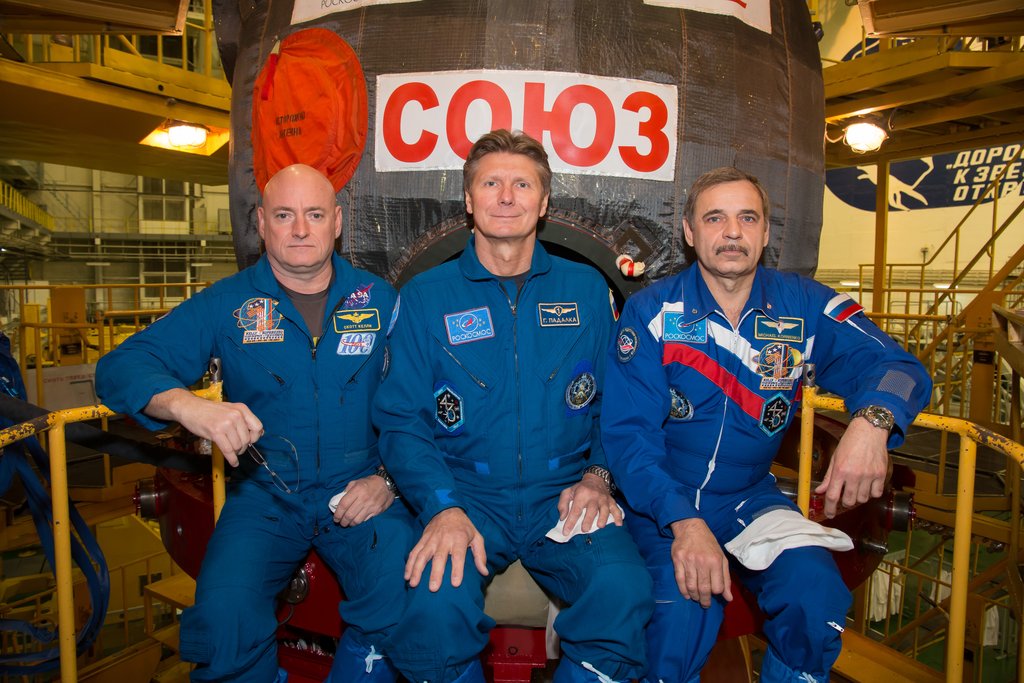Soyuz TMA-16M successfully launched to the ISS
Onboard the ship are space champions

March 15, Baikonur, Kazakhstan, (from left to right) American Scott Kelly and Russians Gennady Padalka and Mikhail Kornienko posing against the backdrop of the spacecraft on which they are to fly to the ISS. NASA / Victor Zelentsov
A few minutes ago, the Soyuz-FG booster rocket successfully launched the Soyuz TMA-16M spacecraft to the International Space Station. On board are two Russian astronauts and an astronaut of the American space agency NASA.
The launch was scheduled to take place from the 1st, Gagarinsky Baikonur site at 22:42 Moscow time. Soyuz will use a fast four-turn scheme, that is, it will dock to a small research module " Search"Six hours after launch from Earth, March 28 at 04:36 Moscow time. The usual scheme takes two days.
The most experienced crew member is Gennady Padalka, he spent 710 days in space and completed nine spacewalks. Padalka pilots the ship, and during his stay on the ISS, he will break the record for the duration of Sergei Krikalyov. Padalka will become the champion of the Earth in the total time spent in space - 878 days. As the astronaut himself said at a pre-flight press conference, he has a dream to achieve a thousand days. In October, Padalka will return to Earth with Danish astronaut Andreas Mogensen and space tourist Sarah Brightman.
But the main focus is on other crew members. Scott Kelly and Mikhail Kornienko will spend almost a year in orbit, they will not return to the planet on March 3, 2016 in the Soyuz TMA-18M descent module. Because of this, Kelly and Kornienko will have to move the lodgement chairs from one ship to another - they are created individually for a particular person to minimize the effect of landing the capsule of the Soyuz capsule. It is impossible to use the same Soyuz for the delivery and return of the annual crew - the ships will not have enough resources for this.
Annual flight is a special experiment to identify the long-term biological effects of space flight . NASA maintains its intentions to land a person on the surface of Mars, so it is necessary to answer many questions: how much muscle and bone mass is lost, how dangerous cosmic radiation is, how the general mood changes under microgravity conditions, and so on. Scott Kelly is great for this, as he has a twin brother . This simplifies the process of comparing health status and physiological parameters. For example, to obtain data on aging, simply compare the length of the telomeres of Scott and Mark. This is also the first annual flight for NASA astronaut, the Russian side already has such an experience.
 During the flight, Kornienko and Kelly will conduct 19 medical and biological experiments . Among them - " Moving fluids". Under microgravity conditions, the liquid in the human body moves upward, without experiencing the usual pressure of attraction of the Earth, this process is exaggeratedly illustrated in the image on the left. For the experiment, the Gamma-1M complex will be used to record the ECG in twelve leads, the Chibis-M pneumatic vacuum suit to create negative pressure in the lower body and a video camera. The information obtained will help determine the direction of the development of preventive measures and treatment regimens - the idea of whether it is possible to temporarily fend off the phenomena of fluid movement by reversing the direction of movement of liquid media will be tested. This is just one of many negative factors for a long flight.. Previous flights of near-annual duration have been carried out for a long time, but today medicine and technology have stepped far forward and allow us to better assess the state of the human body at the station, says Kornienko.
During the flight, Kornienko and Kelly will conduct 19 medical and biological experiments . Among them - " Moving fluids". Under microgravity conditions, the liquid in the human body moves upward, without experiencing the usual pressure of attraction of the Earth, this process is exaggeratedly illustrated in the image on the left. For the experiment, the Gamma-1M complex will be used to record the ECG in twelve leads, the Chibis-M pneumatic vacuum suit to create negative pressure in the lower body and a video camera. The information obtained will help determine the direction of the development of preventive measures and treatment regimens - the idea of whether it is possible to temporarily fend off the phenomena of fluid movement by reversing the direction of movement of liquid media will be tested. This is just one of many negative factors for a long flight.. Previous flights of near-annual duration have been carried out for a long time, but today medicine and technology have stepped far forward and allow us to better assess the state of the human body at the station, says Kornienko.  Probably Scott Kelly took with him a commemorative patch, which is designed to bring him good luck. Last October, at launch , the Antares booster rocket and payload in the form of a private space truck Cygnus exploded . The investigation included the search for surviving objects among the wreckage, and so a fragment of the form for Kelly was found - a patch with the name of the astronaut in English and Russian. Kelly jokesthat the probability of this patch getting into another similar incident is negligible. Of the other features of the attributes of this flight, it is worth noting the absence of the usual hanging toy inside the Soyuz - several GoPro cameras are located in the cockpit, the viewing of which was prevented by the swinging object.
Probably Scott Kelly took with him a commemorative patch, which is designed to bring him good luck. Last October, at launch , the Antares booster rocket and payload in the form of a private space truck Cygnus exploded . The investigation included the search for surviving objects among the wreckage, and so a fragment of the form for Kelly was found - a patch with the name of the astronaut in English and Russian. Kelly jokesthat the probability of this patch getting into another similar incident is negligible. Of the other features of the attributes of this flight, it is worth noting the absence of the usual hanging toy inside the Soyuz - several GoPro cameras are located in the cockpit, the viewing of which was prevented by the swinging object. In case of emergency landing, about 20 military and civilian planes and helicopters, as well as the ship of the search and rescue service of the Russian Navy, insure the flight. The backup crew of the Soyuz TMA-16M were the Russians Alexei Ovchinin, Sergey Volkov and astronaut Jeffrey Williams. Now at the ISS the replenishment is waiting for the Russian Anton Shkaplerov, Italian Samantha Cristoforetti and Terry Woerts, who will stay on the ISS until May 11. On the morning of March 12, they returned to Earth in the Soyuz TMA-14M descent capsuleAlexander Samokutyaev, Barry Wilmore and Elena Serova, and from that moment on the ISS there were three people instead of the usual six. The logo of the annual mission of Scott Kelly and Mikhail Kornienko, NASA, Kelly and Kornienko will spend in orbit twice as many as the usual ISS crew. In a year they will see how 3 Soyuz TMA-M spacecraft arrive at the station, with them astronauts and astronauts, as well as one space tourist Sarah Brightman, her flight duration will be 10 days. Adaptation of an inexperienced person to microgravity must be monitored, on the other hand, this is a British singer and an interesting person who can diversify life in orbit, said Kornienko. Most astronaut will miss

by the nature of the Earth: forests, fields, rivers. In preparation for the flight, Kornienko and Kelly talked with Vladimir Titov, who has an annual flight experience. According to Kelly, Titov advised him not to overwork on the ISS.
